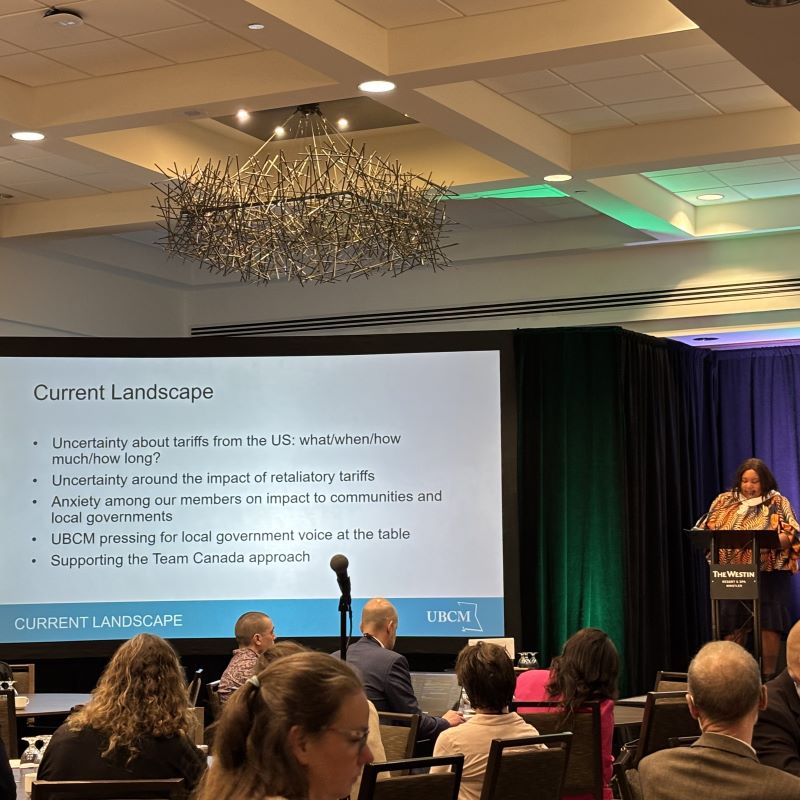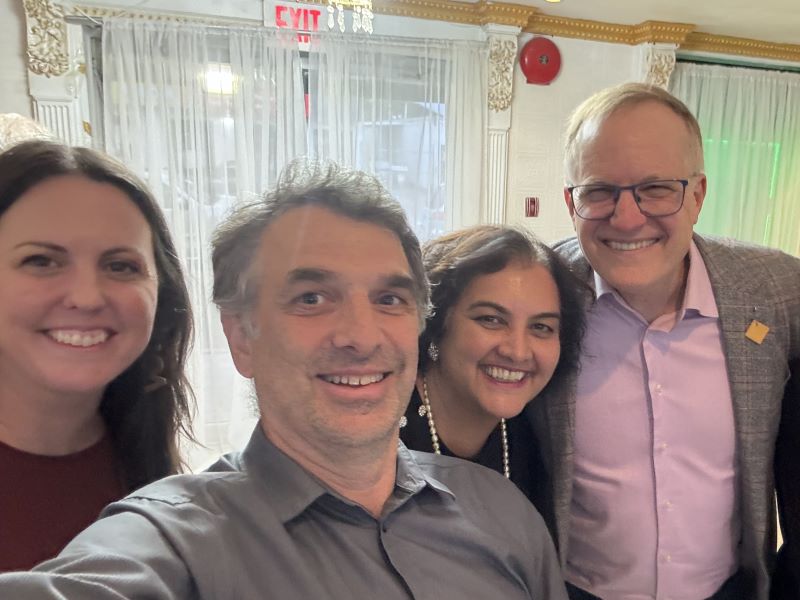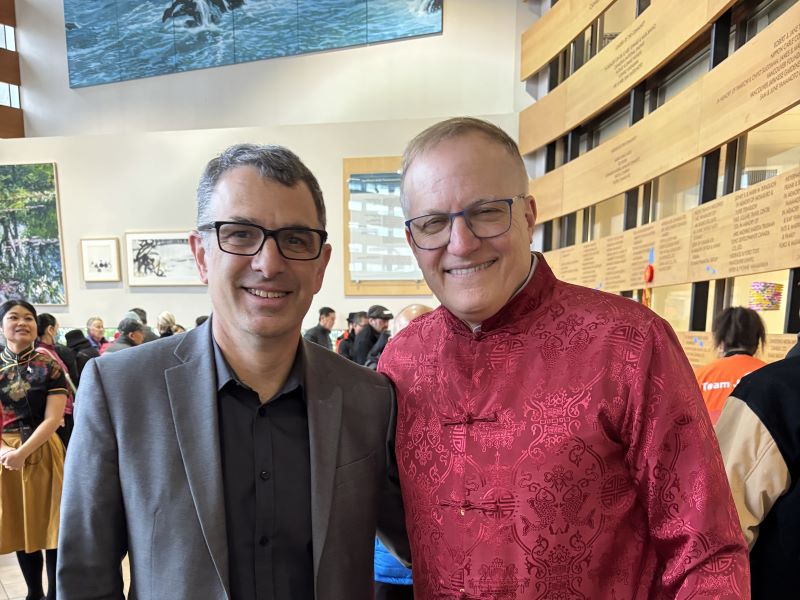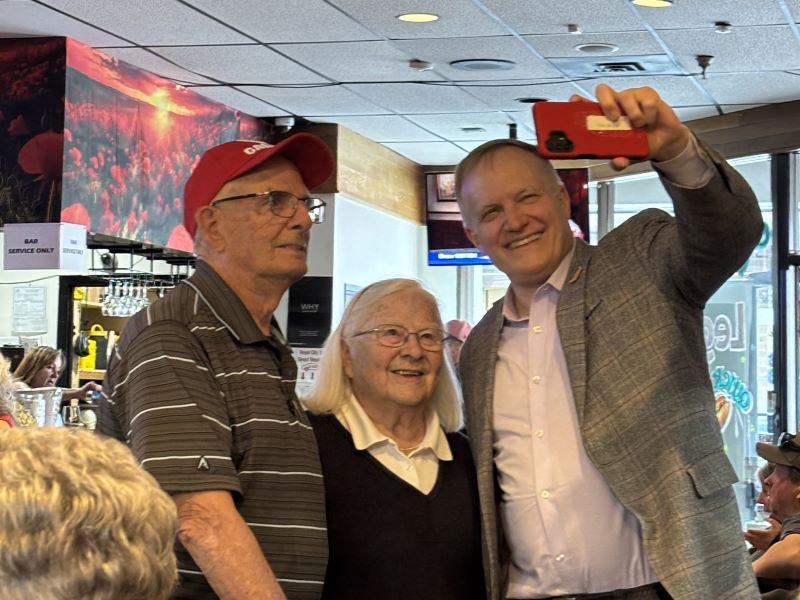We had a long Council meeting, even though we rather rushed through our lengthy agenda. The challenge was that we spent three hours on presentation and delegations, and only an hour doing the actual business, which is a bit of a problem for governance, and something Council is going to have to work on. That said, there was a lot on the agenda starting with:
2024 Financial Statements
The last step of our annual budget process is to prepare and approve the financial statements for last year so they can be submitted to the Province by May 15. These reports outline our financial position as of the end of 2024, and the results of the audit that our finances go under every year.
There is a lot here, but here are a few highlights. The City has an accumulated surplus of just over $1 Billion, but almost 80% of that is tangible capital assets and inventory (buildings, pipes in the ground, vehicle, fleet, computers, etc.). The accumulated surplus went up about $50 Million last year, about half of that being in the form of capital assets because we spent $51 Million in our capital plan last year, which adds to that capital asset pile.
The City has about $457M in financial assets, a 7% increase over last year, and we have $317 Million in financial liabilities, which is less than 1% more than last year. Overall, that means our net financial assets have gone up a bit.
Our revenue was $9 Million more than forecast, mostly related to increased investment interest, and our expenses were slightly (less than 1%) under budget, but there is an accounting adjustment here called an TCA adjustment that offset some unexpected expenses related to emergency events and maintenance costs in buildings.
The other major part of this is the report from our Auditors who found a clean audit, meaning that their review found we were consistent with our legal requirements and Public Sector Accounting Board standards.
Council then moved the following items On Consent:
Amendment to the Water Shortage Response Bylaw No, 6948, 2004 – Minor Revision to Stage 3 Lawn Sprinkling Regulations
The City has bylaws that regulate residential sprinkling and other water uses in the event of a summer water shortage. These bylaws need to be aligned with the Metro Vancouver Drinking water Conservation Plan, so we are making minor edits to align. The change is that new lawns of chafer beetle treated lawns can no longer get a watering restriction exemption once we hit Stage 3 restrictions, which is a fairly significant water shortage emergency.
Heritage Revitalization Agreement and Heritage Designation: 318 Sixth Avenue – Bylaws for First and Second Readings
A property owner in Queens Park wants to build a new house by subdividing their large lot and providing permanent designation to the existing heritage house. A Heritage Revitalization Agreement is the tool to make this work, and that requires a Public Hearing. This report has the details, but I will reserve any comment until after the Public Hearing to respect the process. Council gave the necessary bylaws two readings and a Public Hearing will be held. If you have opinions, let us know!
Programs to Serve Isolated Seniors Funded by the United Way British Columbia
The United Way funds three programs for isolated seniors in New Westminster, providing social meals, a Community Connector program and a Volunteer Coordinator and Support program. Fortunately, our application for 2025 grants to continue these programs was successful, so Council needs to authorize the partnership agreement with the United Way.
Response to Council Motion Regarding the City of New Westminster joining the Strong Cities Network
The Strong Cities Network is a global network of cities dedicated to addressing all forms of extremism, hate and polarization. Membership is free and the benefits include opportunities for better collaboration with elected officials and practitioners in other cities, joining forces with member cities on regional, national and international issues, and general development support for all partners. Staff recommended we join, and we are joining!
The following items were Removed from Consent for discussion:
2025 Tax Rate Bylaw No. 8516, 2025
OK the actual last part of our annual budget process is approving the new tax rates through bylaw before May 15th. This is that bylaw. There are some cool stats in this report for people who are interested in things like that. The total assessed value of all residential homes in New West went up from $27.7 billion to $28.0 Billion. The assessed value of existing property went down a bit ($100 Million) while the value of new inventory added to the City last year went up by $400 Million.
The average detached single home in New West is now worth $1.64 Million (a $20,000 increase over last year), and will pay $4,614 in property tax to the City (an extra $368 over last year). The average apartment home in New West is now worth $690,000 (also a $20,000 increase over last year), and will pay $1,934 in property tax to the City (an extra $187 over last year). If it applies to you, these amounts are reduced by $570 to $845 in Homeowner Grant refunds.
Artificial Turf Field Location- What We Heard: Engagement Summary Report and Next Steps
Council in its wisdom moved the implementation of a new all-weather field ahead of some of the other actions in the upcoming Parks and Recreation Comprehensive Plan, and as a result of very clear consensus from the community about the preferred location, we still need to determine if that location is actually feasible, because soils and groundwater don’t care about public opinion. We have to do the work of understanding the geotechnical and soil conditions of the site, do an archaeological assessment, and deal with details like utility connections and lighting and impacts on the community. Staff will also test the feasibility of a walking track around the field, and of evaluating a second site for an additional field, anticipating that need will arise in the near future regardless. If all goes well, we should have the info to tender early 2026, and have a field in 2027.
City-wide Toilet Strategy: Interim Progress Report
This is a check-in from staff on the work they are doing to address public toilet needs in the City. There has been a lot of work done, engaging both with subject matter experts and the general community to understand what inclusive and sustainable access to toilet facilities requires, and (this is important) the details for us to better understand long-term operational costs and barriers.
Staff also did a detailed analysis of the 30 existing public toilets operated by the City and 9 other key toilet locations under private management, because we fundamentally need to know what is there, and what we can do to make them more accessible before we start filling the gaps. The public outreach part engaged with more than 500 residents (!). Signage is one part of this, but so is extending hours, the implementation of a Washroom Attendant program, the need for improving accessibility – no point having a sign pointing at toilet if it isn’t safe and accessible.
Proposed Next Steps Related to the Council Motion of January 13, 2025 Regarding the New West Hospice Society
Council supported a motion to support the New Westminster Hospice Society in seeking a permanent hospice location in the city, and this is the report back form staff on how we can support them.
There is some learning in here about why there no Hospice Beds in New Westminster, as apparently the BC liberals government of 2009 closed the 10-bed hospice facility at the Queens Park Care Centre, with its resources being relocated to Delta. Addressing this deficit is an ongoing goal of the NWHS. Staff are recommending we support them through joint advocacy to Fraser Health for resources, data support to help in planning and needs assessment, and development application support for finding and developing a location. It is unclear if new Provincial housing legislation allows us to negotiate hospice space as “community amenity” during new residential development, though partnership between Hospice and Developer may still occur, it is unclear right now how we can support that negotiation. This will come back to Council in the upcoming report on City-Wide Financing Growth Strategy.
Response to Council Motion Regarding the City of New Westminster joining the Strong Cities Network
The Strong Cities Network is a global network of cities dedicated to addressing all forms of extremism, hate and polarization. Membership is free and the benefits include opportunities for better collaboration with elected officials and practitioners in other cities, joining forces with member cities on regional, national and international issues, and general development support for all partners. Staff recommended we join, and we are joining
Update on Response to Council Motion: “Enhancing Commercial Areas and Corridors in New Westminster”
Everything I’ve read about the trend of micro-stores and container retailing suggest is either the best thing since sliced bread stands or a fading quirk, but it seems clear that location is vital to its success. It won’t work everywhere, but where it does work, it can really add a boost to a retail area. There was a motion brought to council recently asking for an assessment if there is anywhere in New West it might, and this is the initial response to that motion.
In short, staff have done some preliminary analysis, and are going to dig a bit deeper into capital costs, funding mechanisms, partnership opportunities, and locations. More to come here.
Zoning Bylaw No. 6680, 2001, Storage Amendments Bylaw No. 8518, 2025
We previously saw this Bylaw to remove self-storage as a use-by-right in a couple of commercial zones, though we would still permit self-storage, it would require a rezoning which would give staff and council some more control over design and other factors. It’s coming back because we made some minor amendments to exempt projects already in stream from the change. As this is consistent with the OCP and existing city policies, we are not having a Public Hearing. Council voted to give this bylaw three readings.
We then had three Motions from Council:
Securing Small Business Rebate Funding Renewal
Submitted by Councillor Campbell
WHEREAS in fall of 2023, the Province of British Columbia launched the Securing Small Business Rebate program to provide small businesses with up to $2,000 for eligible commercial property crime and vandalism repairs or up to $1,000 to implement eligible preventative measures; and
WHEREAS the Securing Small Business Rebate program is now closed and the New Westminster Chamber and the Downtown Business Improvement Association have expressed interest for the Province to renew program funding to support the local business community;
THEREFORE BE IT RESOLVED THAT the Mayor, on behalf of Council, send a letter to the Honourable Diana Gibson, Minister of Jobs, Economic Development and Innovation, with a copy to all New Westminster Members of the Legislative Assembly, asking that the Securing Small Business Rebate program funding be renewed.
This program didn’t cost much, but was popular among small businesses for simple repairs and clean-up related to vandalism or other challenges businesses might be facing right now. Happy to support the Chamber and the BIAs in advocating for this program to continue.
Conducting a Review of the City’s Community and Neighbourhood Consultation and Notification Processes
Submitted by Councillor Fontaine
WHEREAS it is important that the City of New Westminster effectively consult and advise local residents and businesses regarding any significant changes or initiatives that may impact their immediate neighbourhood; and
WHEREAS wherever possible the City should properly apprise local residents and businesses if they will be directly impacted by a City initiative or infrastructure upgrade;
THEREFORE BE IT RESOLVED THAT the City conduct an independent review regarding the City’s current consultation and public notification process to ensure it currently meets or exceeds recognized best practices for cities of a similar size; and
BE IT FURTHER RESOLVED THAT staff explore the option to establish an enhanced public notification and consultation process for infrastructure projects and initiatives which are deemed by Council as ‘signature’ or materially ‘significant.’
This was a motion supported unanimously by Council with a minor amendment (see the strikethrough above) that recognizes we may not need a consultant to do this review, but might be able to effectively do it internally. Still, there is some language in here that is important, and the conversation Council had around this is worth watching, because it sounded to me like Council was clearer on the notion than the language of the motion, if that makes sense.
Part of this is the difference between consultation and notification. The City is on the leading edge of public engagement and is quickly building a reputation for leading the region if not the province in how we consult the public in a transparent, accountable, and proactive way. I would say we are not as strong right now in how we communicate strategically with the community, partly because the ground has shifted so much in the communications world over the last few years – the end of newspapers, the quickly evolving social media space, the impacts of COVID on how we meet and interact as a community – and because we simply have not added to our communication team in the City concomitant with the significant increase we are seeing in capital projects in the City.
Part of the problem might be my use of words like concomitant, but I digress…
There is a distinction between consultation and communication. If we are asking for your feedback to help make decisions, we are consulting; if we are letting you know we are building something and that’s why there are trucks in front of your house, that is communication. There are things we consult on, there are things we need to do and asking your opinion if we should is not particularly helpful, and can actually just slow down important work.
I’ll give you a recent example that demonstrates this. During my Mayors Walks last month, I was talking to a homeowner in the West End about rain gardens, he asked why we didn’t consult on the size and locations of the rain gardens in the West End. My honest answer was for the same reason we don’t consult on the size of the sewer pipe we put in the ground or the number of storm drains that open on a street: these things are driven by technical and engineering need, by a volume of water they have to convey for example and slopes and where water wants to flow. Public input really doesn’t supersede that, because it is physics. In that case, notification of the neighbours is all we should be striving for, or asking neighbours to expect.
Some other things are amenable to consultation, like (examples above) public toilet provisions or turf field locations. On these I would suggest the City does an excellent job consulting, both through Be Heard New West and through the various other means our Public Engagement Team is tasked to engage on. However, I can see that notification continues to be challenging with the volume of work our engineering team is working on, and strict project timelines driven by many factors. I have already been talking to engineering and communications staff about some strategies to improve site notices, and I was happy to hear Council in this discussion speaking along pretty much the same lines as I had been using to talk to staff, so there might be some quick wins here.
Removing the 3.5% Climate Action Levy from the 2026 Electricity Bills as part of the Budget Development Process
Submitted by Councillor Minhas
WHEREAS the City of New Westminster has a unique “Climate Action Levy” of 3.5% which applies to all electricity bills for local residents and businesses;
WHEREAS both the federal and provincial governments have now abandoned their failed consumer carbon tax experiment with the aim of leaving more money in the pockets of hard working citizens;
WHEREAS charging New Westminster electricity consumers a special 3.5% levy on green energy can serve to decrease the level of affordability in our city;
THEREFORE BE IT RESOLVED THAT staff be directed to permanently eliminate the 3.5% Climate Action Levy as part of the 2026 budget, which will be presented to Council for review and approval.
I will not repeat what I have written every time this motion has come to us, you can read some of my responses at those times here, or here as just a couple of examples. Instead I will note that we received a half dozen pieces of correspondence from the public on this motion and all of them were in opposition to the motion. But its not the numbers, necessarily, it is the quality of the argument made, so I will quote directly from those correspondence and let the people be heard:
“The cost of inaction is greater than the cost of taking action now. I am frustrated that motions to ax this levy keep being made. We know climate change is real, it’s us and it’s bad…and we know we have the solutions! Delay tactics are just making the crisis worse. For our kids, it is imperative that we speed up climate solutions and action, not delay it debating over levies.” – KC
“Similar motions have been defeated in the past, and there is every reason to defeat it again: polluting emissions from the fossil fuel industry are bringing extreme weather events like the 2021 heat dome, and New Westminster must prepare for the next one. As well, Councillor Fontaine pointed out in 2023 that we would be taking a $2 million hit on the funds that let this city take action on climate We know that a safe and healthy city means preparing for the effects of carbon pollution. Keep the levy, and help keep the city prepared.” –HB
“The 3.5% levy on the electrical bills amounts to a few dollars a month and does not make a significant saving to an individual but what it has done as a Climate Action Levy is significant. It does and will make a difference in savings to all of us in the next years as we work together to try to implement the solutions that are available to reverse the damage that has been done through negligence and lack of knowledge. We have a growing contingency fund that can make a difference. I urge you to defeat this motion.” – BF
“I urge councillors to stop bringing forward council motions that aim to remove the climate action levy. This is a waste of council and staff’s time going over this again and again when it’s already been defeated multiple times in the past. If the mover of this motion would like it to be directly funded through property taxes instead with no change to actual climate action programs, please state that. Or, if it’s really not believed that the city should be doing anything to fight or adapt to climate change, then please state that clearly. But to keep bringing something like this forward is doing no service to anyone.” –MH
“While affordability is a critical issue for many New West residents right now, I believe it is critical that we remain firmly committed to the climate goals collectively set by the City of New Westminster. The youth of our community, who can not yet vote, are relying on our current elected officials to provide the climate leadership now that will help secure their future. Prioritizing short term economic savings in exchange for climate action funding is absolutely not in my and my neighbours’ best interests, nor the best interests of the next generation of New West residents.I want to pay taxes and levies that support building a climate resilient city.” –LK
“Please keep the climate action levy in place to do the job it is now doing for our citizens, preparing us to meet an uncertain future and doing what we can as a municipality to reduce emissions. The choice laid out by some politicians of sovereignty or a livable planet is a false choice. There is no sovereignty on a dead planet.” –TT
Couldn’t have said it better myself.
Finally, we had two Bylaws for Adoption:
Zoning Bylaw No. 6680, 2001, Miscellaneous Amendments Bylaw No.8495, 2025
This bylaw that makes routine miscellaneous amendments and language corrections to the zoning bylaw was adopted by Council.
Zoning Bylaw No. 6680, 2001, Multiple Unit Residential Storage Requirements Amendments Bylaw No. 8519, 2025
This Bylaw that requires the provision of increased personal storage space for residents in new multiple unit residential buildings was adopted by Council.
And that got us to the end of a nights business, with yet another council meeting next week in a unique back-to-back session, we have lots more to get done!









